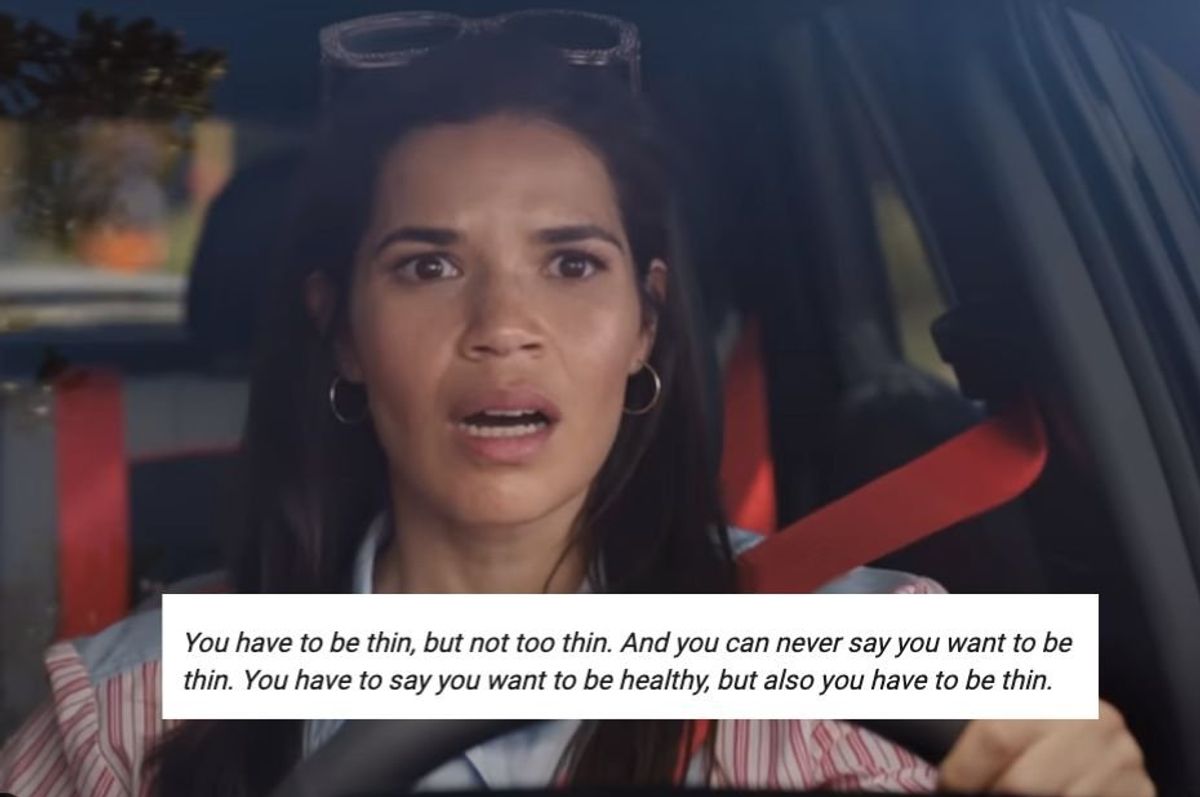We can't get enough of America Ferrera's 'impossible to be a woman' monologue in 'Barbie'
She gave voice to what so many women feel but can't articulate.

America Ferrera plays a mom of a teen girl in "Barbie."
"It is literally impossible to be a woman."
At some point, most women find themselves confronted with the truth of those words, along with the 300 or so that follow them in America Ferrera's monologue scene in "Barbie."
The "impossible to be a woman" monologue has been a major talking point of the film, with parts or all of it being shared widely on social media, and when you read it—especially if you are a woman, but even if you aren't—it's easy to see why.
It's hard to explain the context of the scene in which she gives the speech without giving away too much of the plot, but let's just say that Barbie is going through an existential crisis and Ferrera is talking to her (but also to her young teen daughter, and to all women, and to everyone, really).
Here's the text in full:
"It is literally impossible to be a woman. You are so beautiful and so smart, and it kills me that you don't think you're good enough. Like, we have to always be extraordinary, but somehow we're always doing it wrong.
You have to be thin, but not too thin. And you can never say you want to be thin. You have to say you want to be healthy, but also you have to be thin.
You have to have money, but you can't ask for money because that's crass. You have to be a boss, but you can't be mean. You have to lead, but you can't squash other people's ideas.
You're supposed to love being a mother, but don't talk about your kids all the damn time. You have to be a career woman but also always be looking out for other people.
You have to answer for men's bad behavior, which is insane, but if you point that out, you're accused of complaining. You're supposed to stay pretty for men, but not so pretty that you tempt them too much or that you threaten other women because you're supposed to be a part of the sisterhood.
But always stand out and always be grateful. But never forget that the system is rigged. So find a way to acknowledge that but also always be grateful. You have to never get old, never be rude, never show off, never be selfish, never fall down, never fail, never show fear, never get out of line.
It's too hard! It's too contradictory and nobody gives you a medal or says thank you! And it turns out, in fact, that not only are you doing everything wrong, but also everything is your fault.
I'm just so tired of watching myself and every single other woman tie herself into knots so that people will like us. And if all of that is also true for a doll just representing women, then I don't even know."
Phew. So many of us saw ourselves in what she described.
"There's no woman in my life who those words aren't true for," Ferrera told The Los Angeles Times. "Not a single one. And when we hear the truth, it hits in a certain way, and you can't unhear it."
But it wasn't just a moving moment for women. The film's creator and writer of the monologue, Greta Gerwig, told Variety about what it was like on set during the filming, "When America was giving her beautiful speech, I was just sobbing, and then I looked around and I realized everybody’s crying on the set. The men are crying, too, because they have their own speech they feel they can’t ever give, you know? And they have their twin tightrope, which is also painful. There’s something about some of these structures that are just, you know, ‘Somebody make me stop!’ That’s sort of, I suppose, the feeling behind Ken.”
Why do we do this to ourselves? Or rather, why do we allow the amorphous, intangible entity "society" to do this to us? The contradictory expectations we feel compelled to meet even while railing against them are maddening. But they exist, so we either strive to meet them, which we can't, or we expend energy constantly fighting off the messaging that makes us want to meet them. It's exhausting either way.
And that last line—"If all of that is also true for a doll just representing women, then I don't even know." Dang. Let's just sit with that for a minute.
Well done, Greta Gerwig, for nailing the reality of womanhood.
(And if that monologue doesn't make you cry, don't worry. Billie Eilish's original song for the film that rolls during the credits will probably do it. Gracious.)
- America Ferrera's speech at the Women's March sends a powerful message against hate. ›
- Margot Robbie reveals the adorable 'favor' she requested while shooting the 'Barbie' movie ›
- 'Barbie' movie creators open up about film's feminist message and fans are loving it ›
- Billie Eilish's 'What Was I Made For?' used in TikTok video - Upworthy ›




 An upset woman sits in her car.via
An upset woman sits in her car.via  An upset man grabs his head.via
An upset man grabs his head.via  A stressed-out woman.via
A stressed-out woman.via 
 Meatloaf was a staple dinner.
Meatloaf was a staple dinner. Spaghetti is still a classic.
Spaghetti is still a classic. Why were pork chops so popular?
Why were pork chops so popular?
 David Bowie on swing in red suit
David Bowie on swing in red suit David Bowie album cover
David Bowie album cover Prince
Prince
 We really wish this were true. via @bryaninmsp/
We really wish this were true. via @bryaninmsp/